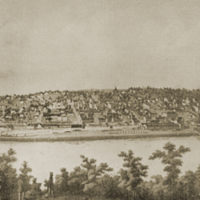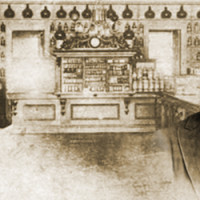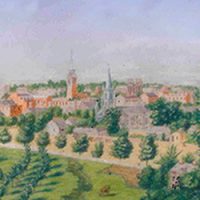Speculation has long existed that the R.E. Russell storecard featuring Feuchtwanger’s Obverse-6 die was struck for a New York City merchant or business. Russell Rulau in his token guides has asserted this, and many other numismatists have naturally assumed that because the token features Feuchtwanger’s eagle; it was presumed to have been prepared for a New York merchant.
 Cataloged as HT-309, the token was struck in German Silver and features Lewis Feuchtwanger’s Obverse-6 design.
Cataloged as HT-309, the token was struck in German Silver and features Lewis Feuchtwanger’s Obverse-6 design.
The emission deviates from Feuchtwanger’s usual one-cent storecard in that its denomination was 12½ cents.
Additionally, instead of Feuchtwanger’s usual reverse, engraved atop the emission is the name ‘R.E. Russell.’
Assumed to be name of an issuing merchant, it features the acronym ‘I O U.’ Presumably, it means “I owe you.”
Despite the historical assumption that R.E. Russell was a New York City merchant, anyone who has taken even a cursory moment to research the origins of the storecard has quickly found that associating a New York City merchant with the token is impossible. None of the contemporary New York City directories list an R.E. Russell.
Other numismatists including David Bowers have conducted exhaustive research on many of the Feuchtwanger emissions.
In his More Adventures with Rare Coins the token is briefly mentioned, but no issuing merchant is identified. Later, during direct correspondence with Bowers, he confirmed that thus far numismatists have been unsuccessful at attributing any merchant with the token.
A Broader Search
Previous die analysis incontrovertibly connects the firm of Bale and associates with the Feuchtwanger emissions. The same firm has also been connected with Richmond’s Beck’s Public Baths token. Moreover, die analysis also connects the R.L. Baker storecard to Bale and associates similarly. These connections affirm the great geographical reach that the private mint had.
Based on these earlier findings by others, the author had to consider the possibility that the R.E. Russell token may have been struck for a merchant far away from New York City. Expanding his search to include the entire United States, via libraries, newspaper archives, and other historical sources from outside the New York City area, there was but only one merchant found that used R.E. Russell moniker around 1837. That merchant was Robert E. Russell of Columbia, South Carolina.
Born in 1795, Russell had long been resident of the town, and began his entrepreneurial endeavors first as a tailor, and then as a furniture salesman.
Later, in the 1830s, Russell pursued botany, focusing his business on the sale of seeds, saplings, trees, fruits, and flowers.
Contemporary newspapers of the time attest that his business quickly flourished. Beginning through the late 1830s, and continuing through the mid-1850s, Russell was a prolific advertiser. Plants and seeds of many types, including fruit trees, evergreens, strawberries, and turnips were often advertised. Russell was a frequent traveler. Many of his advertisements announced his return from buying trips made to cities throughout the northeast.
Other types of plants including those used in the silk trade were cultivated, promoted, and exhibited. To improve his business, Russell opened his own “botany garden.” There he both exhibited his plants as well as grew them from seedlings to confirm their vigor.

Fayetteville [N.C.] Observer, 08/21/1839
Following success in the seed business, Russell branched out and diversified. In the early 1840s on the same grounds of his botanical garden, he opened a public bath facility. There customers could enjoy a warm or cold bath.

A decade later, in the early 1850s Russell opened The Palmetto House hotel nearby to his Botany Garden.

In 1854 Russell died. News of his passing was publicized via a tribute, published in the The Daily South Carolinian on March 14, 1854.
Well admired by the community, he was a mere 59 years old at his death. Using data obtained from the 1850 Federal Census, he was survived by a wife and at least five children.

Numismatic Validation
It has finally been determined incontrovertibly that Robert E. Russell of Columbia, South Carolina is the same R.E. Russell on the storecard. Both the man and the token used the same “R.E. Russell” moniker. Both the man and token were contemporaries. Indeed, what appears to remain uncertain is whether the storecard was issued for his seed business, his public baths, as an admission token, or his boarding house.
Of the prolific number of R.E. Russell advertisements uncovered and viewed, none encountered thus far allude explicitly to a token. However, two different possibilities exist that infer pricing plausibly associated with the token.

The first possibility suggests it could have been an admission token to his Botanical Garden. Russell frequently provided instructions and guidance to planting and horticultural techniques, as well as showcased exotic specimens he personally cultivated.
A classified advertisement in August 1845 announces the exhibition of a Duck Plant (Aristolochia). Members of the interested public could visit the garden and partake in the unique curiosity for an admission price of 12½ cents:

A second possibility suggests a connection to his advertisements placed in the summer of 1840. Although no explicit pricing relates specifically to 12½, the advertisements allude to pricing based on bits. His advertised cost for a cold bath was set at 2-bits, while the advertised cost for a warm bath was set at 3-bits. Since 12½ cents equals a bit, two or three of the R.E. Russell HT-309 tokens could purchase a bath.

Confirmation
Finding the actual location of Russell’s storefront, garden, and public houses was aided by the book Random Recollections of a Long Life, 1806 to 1876, a memoir written by longtime Columbia resident Edwin J. Scott in 1884. In chapter IX of his book, he writes:
“Opposite the State House Robert E. Russell, formerly a tailor, had somewhat later, a flower garden of an acre in extent, where he received a handsome income from the sale of roses and other plants. He lived at the northwest corner of Washington and Assembly streets…”
While on first glance of Scott’s account, one would presume it would be easy to confirm the whereabouts of Russell’s garden. However, the events of the Civil War greatly complicated the search. Towards the end of the war the [South Carolina] State House that Scott references was burned to the ground. While construction of a new state house had already been underway since before the war, nothing much remained of the existing State House itself, or much of the blocks that immediately surrounded the building. Thus, examination of any maps drawn after the war would be pointless.
Irrefutable evidence of Russell’s property could only be confirmed once a pre-war map was found and examined. Through extensive research, an 1850 map of Columbia South Carolina was finally located.

Squarely depicted on the map is Russell’s lot. Confirming Scott’s account, it was located directly adjacent and northeast of the original State House. Situated on the corner of Senate and Richardson streets, it was diagonal of the town’s Episcopal Church.

While there had remained one yet unreconciled question which could immediately rule out whether the R.E. Russell of Columbia South Carolina is the same R.E. Russell depicted on the HT-309 storecard. That was because inconsistencies in the spelling of R.E. Russell’s name in both his advertisements and also on the map above. However, this question was finally put to rest when one examines the 1850 U.S. Federal Census record of 1850. Was Russell’s name spelled with only one L or was it spelled with two?
The 1850 Federal Census confirms it was spelled with two Ls:

Numismatic Pricing
The following table outlines hammer prices for R.E. Russell tokens going back to 2005. The table is sorted by grade and hammer price.

After statistically normalizing hammer prices, the following table lists what collectors may expect to pay for various grades of the R.E. Russell token. Pricing that significantly deviates from these should be avoided.; most especially those which have been deemed ‘details’ grade by NGC, PCGS, or ANACS.
While the prices listed in Russell Rulau’s Standard Catalog of United States Tokens, 1700-1900, Fourth Edition, deviates from the prices below, collectors should remember that Rulau’s guide is over a decade old. The pricing below reflects actual sale prices years after Rulau’s guide was published.

Aaron Packard ![]()
Notes and Sources
- Standard Catalog of United States Tokens 1700-1900 Fourth Edition, Russell Rulau, Krause Publications, ©2004, pg.174
- More Adventures with Rare Coins, Q. David Bowers, Bowers & Merena Galleries, ©2002
- The Telescope, Columbia SC, various dates and advertisements
- Columbia Telescope and South Carolina State Journal, Columbia SC, various dates and advertisements
- Daily National Intelligencer, Washington DC, various dates and advertisements
- Columbia Telescope, Columbia SC, various dates and advertisements
- South-Carolina Temperance Advocate, Columbia SC, various dates and advertisements
- Fayetteville Observer, Fayetteville NC, various dates and advertisements
- South-Carolina Temperance Advocate, Columbia SC, various dates and advertisements
- South Carolina Temperance Advocate and Register of Agriculture and General Literature, Columbia SC, various dates and advertisements
- The Daily South Carolinian, Columbia SC, various dates and advertisements
- Map of Columbia, S.C. and suburbs, c.a. 1850, Arthur & Moore, University Archives, University of South Carolina Buildings and Grounds
- Random Recollections of a Long Life, 1806 to 1876, Edwin J. Scott, C. A. Calvo, Jr., 1884, pg.41
- The United States Census of 1850
- The Library of Congress Digital Archives
- Correspondence with Tony Chibbaro, South Carolina Numismatist, Author, and Historian, 2013-2014
- Correspondence with Steve Hayden, South Carolina Numismatist and Author, 2013
- Correspondence with David Schenkman, Numismatist and Author, 2013
- Correspondence with Q. David Bowers, Numismatist and Author, 2013
- New York’s Crystal Palace & The H.B. West Tokens - November 6, 2019
- Edward Aschermann’s Cigar & Tobacco Tokens - November 2, 2019
- George T. Hussey & His Special Message Tokens - October 30, 2019










Love the research! The connection is intriguing and the supporting information very interesting.
Not sure if you have this (or if it helps), but a typescript image of the will of Robert E. Russell is available online (additional information from his estate packet might potentially be helpful): http://www.archivesindex.sc.gov/onlinearchives/Thumbnails.aspx?recordId=298725
There is also a petition and a report on the petition on file concerning his opening of the garden, although there is no online record: http://www.archivesindex.sc.gov/onlinearchives/RecordDetail.aspx?RecordId=249176
http://www.archivesindex.sc.gov/onlinearchives/RecordDetail.aspx?RecordId=266156
And a petition by his widow concerning wages owed for his work on the statehouse grounds: http://www.archivesindex.sc.gov/onlinearchives/RecordDetail.aspx?RecordId=259152
Excellent information Heather. Thanks for contributing. It is much appreciated!
Aaron,
You always do a great job of researching and writing about tokens, and such is certainly the case with your article on the R.E. Russell token. We have corresponded about this token before, and I believe I related to you at that time my hesitancy to accept your attribution to Columbia, SC. My reluctance was primarily based on the fact that, to my knowledge, none of these tokens had ever turned up locally. If the tokens were actually used in Columbia, one would think that at least one of them would have come to light in the collection of some old-timer in Columbia or would have been unearthed by a metal-detecting relic hunter nearby.
Well, I want to let you know that I have had a change of heart and am “jumping on the bandwagon” of your attribution to Columbia. This is due to the fact that there are presently on eBay (July 1, 2014), not one, but two R.E. Russell tokens from a seller in Charlotte, NC. I have contacted this seller (a local coin shop) and found out that the tokens were purchased in two separate transactions several years apart. The odds of a single coin shop in Charlotte purchasing two rare NY tokens would be astronomical, but the odds would be much better if the tokens were from a city only 85 miles distant. Over the years, I have purchased numerous South Carolina tokens from dealers in the Charlotte area as the city is only ten miles from the South Carolina state line.
I would also like to let you know that I will be listing this token in the next edition of the South Carolina token book.
Regards,
Tony Chibbaro
Thank you very much Tony! You are the country’s foremost expert on South Carolina tokens; I am greatly appreciative of your support of the attribution!
Aaron,
Just a short note to let you know that I recently visited the coin shop in Charlotte that I mentioned in my last post to your site. This was the shop that had two examples of the R.E. Russell token that they had purchased over the years in separate transactions. Well, when I arrived they proudly showed me a THIRD (!!)specimen during my recent visit. It had just been purchased from a local resident who had brought in a few coins that had been inherited from his parents. In my view, that is strong proof that the token is from somewhere in the South. But, it should also underscore that a possible connection to Charlotte needs to be ruled out.
Regards,
Tony Chibbaro
Hi Tony –
As discussed, any plausible connection to Charlotte has been ruled out. Extensive searches and exhaustive queries were made using Gale Cengage InfoTrac, as well as databases at the Library of Congress and HathiTrust. No contemporary (nor modern) records were found that associated any R.E. Russell with the city of Charlotte North Carolina.
Thanks,
Aaron